Eating vegan in India can be difficult because dairy is used in a lot of dishes. My girlfriend is a vegan though, which means I’m vegan most times, and we’ve made it work without missing out on too many delicious foods.
To eat vegan in India, you’ll need to avoid ghee, which is a common cooking oil and ingredient. You can find vegan restaurants using sites like Happy Cow and Vegan First. Cities like Mumbai, Rishikesh, and Goa have more vegan options. Plus, there are 36 common vegan-friendly Indian dishes to know.
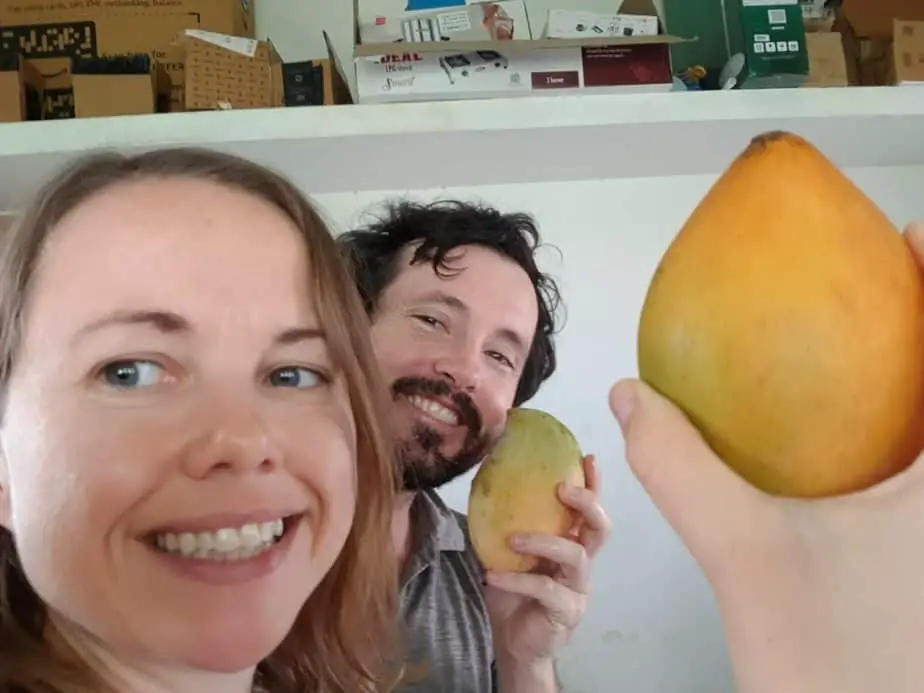
India is the “vegetarian capital of the world” with about 30% eating only vegetables, so why is it so hard to be vegan in India?
Eating vegan can be a challenge in any culture, but it can be especially difficult since cows and dairy products are a central part of the culture in India.
Hindus make up 83% of the population in India, and rever the cow as their “mother.” Dairy products like ghee and milk are not only a primary part of their diet but they also play a big role in religious ceremonies.
If you’re wanting to eat vegan on your India trip or living here and wanting to try out this healthy diet, you can develop a bullet-proof plan with the tips below.
Why Is Eating Vegan in India Challenging?

Dairy is an essential part of the Hindu religion and an Ayurvedic diet.
Ghee has been used in Indian recipes for hundreds of years, maybe thousands. Ghee is thought to help digestion and is even used to heal your skin when burned.
Ghee can be stored for up to 3 months without going rancid with refrigeration, so you can imagine it was an essential dish in India before refrigerators.
“Ghee is, no doubt, clarified butter, but it is also something more, in the same way, that wine is more than the juice of a squeezed grape. Ghee is like a genius born to a dull parent.”
R.K. Narayan, Indian Author
For all of these reasons, many Indians use it for cooking and as an ingredient in masalas, curries, flatbreads, and more. Therefore, if you’re eating vegan in India, ghee is the food that will be the hardest to avoid.
In Hinduism, ghee or clarified butter is not only a food, but it is also used in religious ceremonies. Near the city where I live, there is a mountain that is considered holy. During the holiday of Diwali, locals haul 2,000 liters of ghee to the top of the mountain, then pour it into a huge container. The ghee is then used as fuel for a huge fire that lasts for 10 days of the celebration.
In the Vedas, which are the primary Hindu spiritual texts, ghee is an essential offering to fire. During funerals, marriages, and other family ceremonies, ghee will be poured onto a ritual fire.
Ghee is also used in diya candles by many families during Diwali.
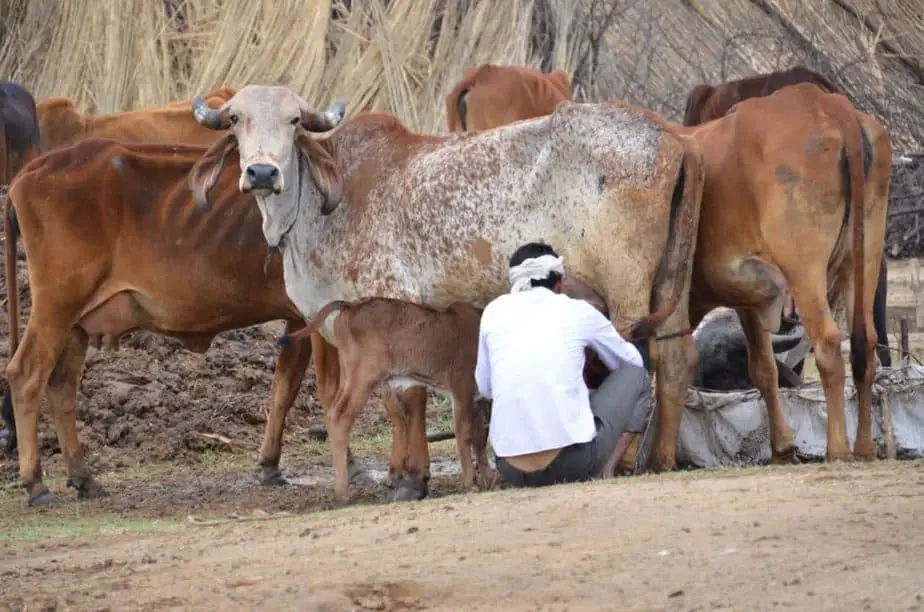
The other common food you’ll have a difficult time avoiding is milk. India produces more milk than any country in the world. In 2017, India produced 176.27 million tons of milk, while the country with the second-largest milk production, the United States of America, produced only 97.76 million tons of milk. That’s 180% more milk!
In Hinduism, milk has a purifying quality. Hindus bathe idols in milk on holidays or make offerings of milk and yogurt during holidays like Diwali.
The health system known as Ayurveda was also recorded in the ancient Hindu texts known as the Vedas and is thought to have originated 6,000 years before Christ.
Ayurvedic medicine is practiced in some form by 90% of Indians, according to the University of Minnesota’s Center for Spirituality and Healing.
Another study found that even among Asian Indians who had moved to California:
- 95% knew about Ayurveda
- 78% had knowledge about treatments or products
- 59% were currently using Ayurvedic treatments or products
In Ayurveda, milk is recommended because of its unique nutritional content.
Milk, when digested properly, nourishes all the tissues, promotes balanced emotions, and helps balance all the doshas.
VPK by Maharishi Ayurveda
With these 10 tips though, you can stick to eating vegan and enjoy your India trip!
1) Substitute Ghee With Vegetable Oil
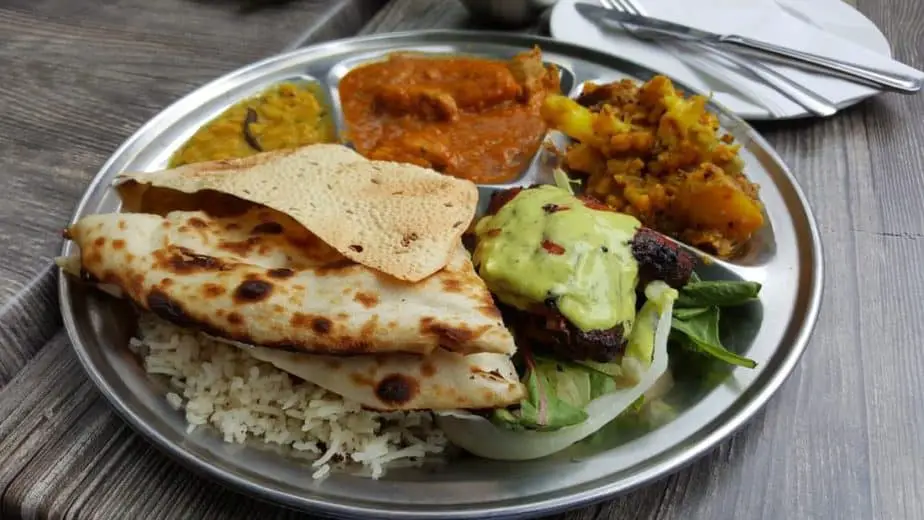
When visiting restaurants, simply ask that the ghee be substituted for another oil.
Vegetable, coconut, or mustard oil are often used in India as well.
Many restaurants in India are known for their hospitality… “The guest is equivalent to God” or “Atithi Devo Bhava” is the mantra of India’s tourism industry and many merchants are more than happy to help you have an amazing time.
One challenge you may find is that the merchant does NOT understand what you mean… “No milk? No ghee?” Veganism is not as common here as in Western cities. But don’t worry I have a tip for getting the point across…
2) Explain You Are Jain

Veganism isn’t new in India and will be commonly understood in big cities. But if you’re in a smaller destination, or in places where English isn’t spoken fluently, you may have a difficult time getting your waiter to understand what you want don’t want ANY ANIMAL PRODUCTS in your food.
One way you can explain this point to them is by saying you practice the Jain religion.
Jain is one of Indian’s most ancient religions. Jains follow the principles of non-violence even requiring that no insects be hurt in the making of the food.
Therefore, you can explain that you don’t eat any animal products for this reason, and they will better understand what you are looking for.
But a better option is to find restaurants that only serve vegan dishes. Now it can be difficult since they are rare, but here’s an easy way to find them…
3) Use Vegan-Friendly Restaurant Search Engines
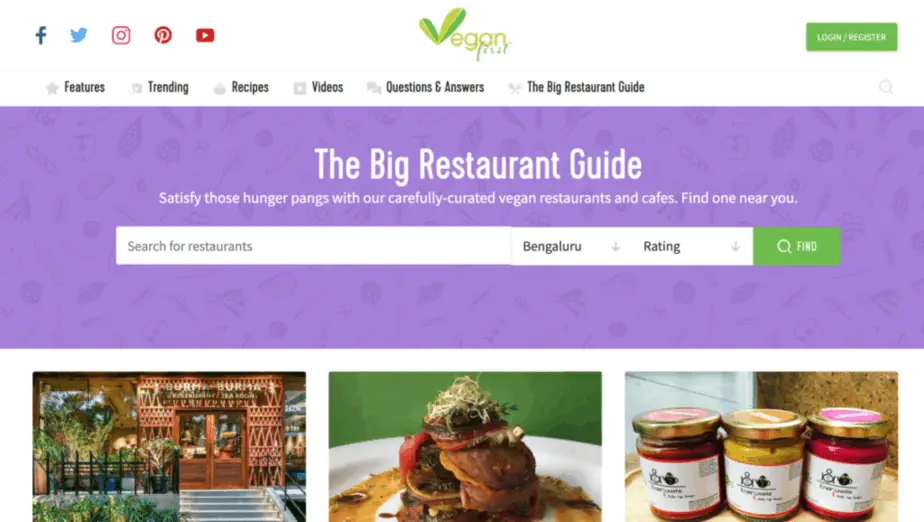
If you’re traveling around India, search for vegan-friendly restaurants.
Vegan First has a list of 155 restaurants in cities such as New Delhi, Mumbai, Goa, Chennai, Bengaluru, and others.
This is such a good resource because it can take the worry out of your meal. No need to explain yourself or worry that some ghee or milk was accidentally added to your food.
Plus, you might meet some other vegans in your travels… many of these restaurants are super chill cafes that you might meet some travel partners at.
Happy Cow is a similar website, offering vegan and vegetarian and it has 74 restaurant listings across India. There are 908 vegetarian restaurants though which would be a good second option, since these restaurants may be better able to help you find a vegan dish.
In big cities like Bangalore, you can find 5 vegan restaurants. Mumbai has 14. Jaipur has 4. Arambol in Goa has 4.
4) Visit Vegan-Friendly Destinations
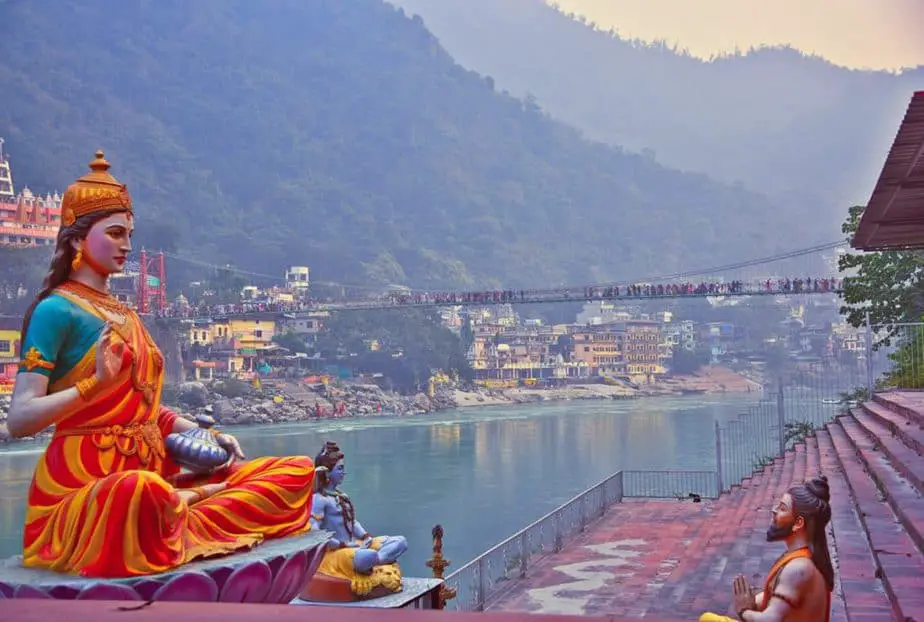
Some cities are going to be easier to find vegan restaurants or vegan dishes than others. Look for Indian cities that cater to yoga practitioners and other spiritual travelers.
For instance, Rishikesh is the “Yoga Capital of the World” and has lots of yoga and meditation retreats. It also has a strict no-meat rule! Here you can find plenty of yogis who are vegan and looking for vegan options at their restaurants.
Bengaluru was named the most “vegan-friendly city” in 2014. Pune, Chennai, and Hyderabad have also won the award.
If you’re planning a trip and want an easier time finding vegan meals, then add these destinations to your itinerary:
- Goa
- Rishikesh
- Dharamsala
- Mumbai
- Auroville
- Mysuru (Mysore)
- Bengaluru (Bangalore)
- Pune
- Chennai
- Hyderabad
- Indore
But you probably want to visit other beautiful and more traditional destinations in India, so it will help to know these common vegan-friendly dishes.
5) 30 Common Vegan-Friendly Dishes
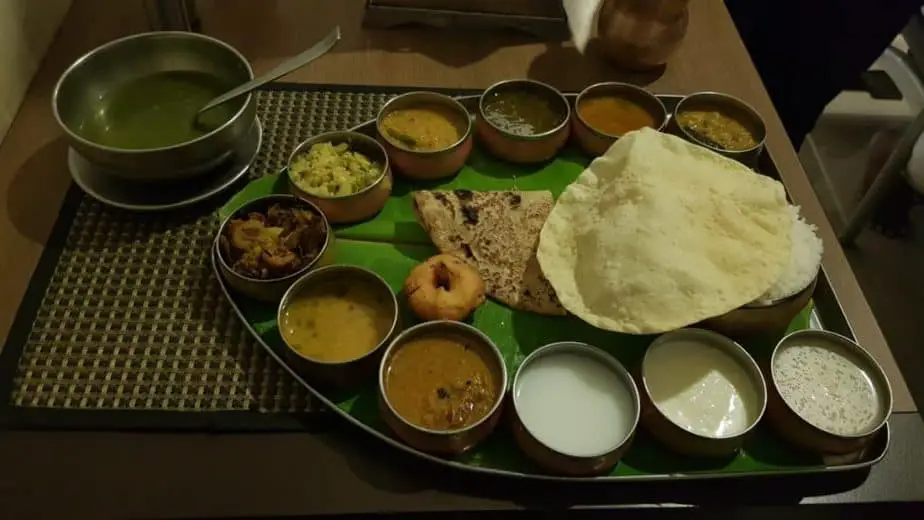
The easiest way to eat vegan in India is to know which dishes are usually vegan.
Chinese, Thai or Vietnamese restaurants have more typically vegan dishes since their vegetarian dishes are usually vegan as well. They don’t use a lot of diary.
South Indian food has more vegan options than North Indian.
Foods that are definitely NOT vegan:
- Naan: It’s cooked with milk.
- Parotta: It’s cooked with eggs.
- Bhatura: It’s cooked with curd.
- Paneer: It’s cheese.
But these common 36 foods are vegan already, or can be easily made vegan if you request no ghee or milk be used:
- Thali: This is the most common dinner in North India and lunch in South India. Ask for no yogurt, paneer, or rice pudding.
- Pakora: A popular street food with vegetables and spiced bread. Check to be sure there is no meat or dairy used since there are many varieties.
- Samosas
- Stuffed Parantha
- Vegetable Biryani: Ask that no ghee was used in cooking.
- Puri: Flatbread, check that no ghee was used.
- Roti: Flatbread, check that no ghee was used.
- Chana Masala: A spicy chickpea dish
- Bhindi Masala: Stir-fried okra
- Misal Pav: A street food with beans in a spicy curry and an Indian bread roll, then topped with a mix of onions, lemon, coriander, and potatoes.
- Khachu
- Chapathi: Ask that no ghee was used in cooking.
- Dal Tadka: A spiced lentil dish, ask that no ghee was used in cooking.
- Dal Chaawal: A lentil rice casserole
- Masala Dosa: Common dinner in South India with the dosa which is a thin pancake and stuffed with potatoes and curry. Ask for no ghee.
- Beetroot Thoran: From Kerala, it has diced beets, coriander, ginger, chili, and other spices.
- Bhelpuri: Puffed rice, veggies, and a savory tamarind sauce. Found in Western India.
- Khichdi: Rice and lentil dish, like a salty porridge.
- Rajma: A red kidney bean dish
- Hara Bhara Kebab: Kebabs made from spinach, potatoes, and peas
- Baingan Bharta: Minced eggplant usually found in the Punjab region.
- Aloo Puri: Puffed bread with potatoes inside.
- Chole Bhature: A fried bread made in North India, ask that no ghee was used.
- Gobi Manchurian: Fried cauliflower dish
- Vegetable fried rice: Ask that no ghee was used
- Veggie momos
- Spicy chickpeas in a stuffed bun
- Tofu burger
Indians love sweets and you won’t want to miss out, so here are some Indian dessert options:
- Pukhlein: Rice flour bread from Northeast India
- Ela Ada: Rice flour with sweets in dough from Kerala
- Tilkut: Seasame seeds and sugar
- Chikki: Nuts and sugar
- Pori Urundai: Puffed rice balls
- Kuluku Roti: Flour and sugar pudding
- Suzhiya: Sweet dough balls
- Vegan ice cream with coconut milk
6) Stock Up On Vegan-Friendly Snacks

In between meals at restaurants, have a steady supply of vegan-friendly snacks to keep your energy high.
My girlfriend always keeps nuts, seeds, fruits, and dates around because she knows that when she gets hungry, she’s going to look for the closest places to eat… which may not be vegan.
These snacks are commonly found in Indian grocery stores:
- Pumpkin seeds
- Peanuts or ground nuts
- Raisins
- Sunflower seeds
- Peanut butter
- Cashew butter
- Almond butter
- Flax seeds
- Chia seeds
- Bananas
- Sesame seeds
- Yoga bars or protein bars
Nuts, fruits and butters from Auroville are often roasted without oil and super healthy, although you’ll pay a bit more for them.
7) Enjoy The Fruit Markets
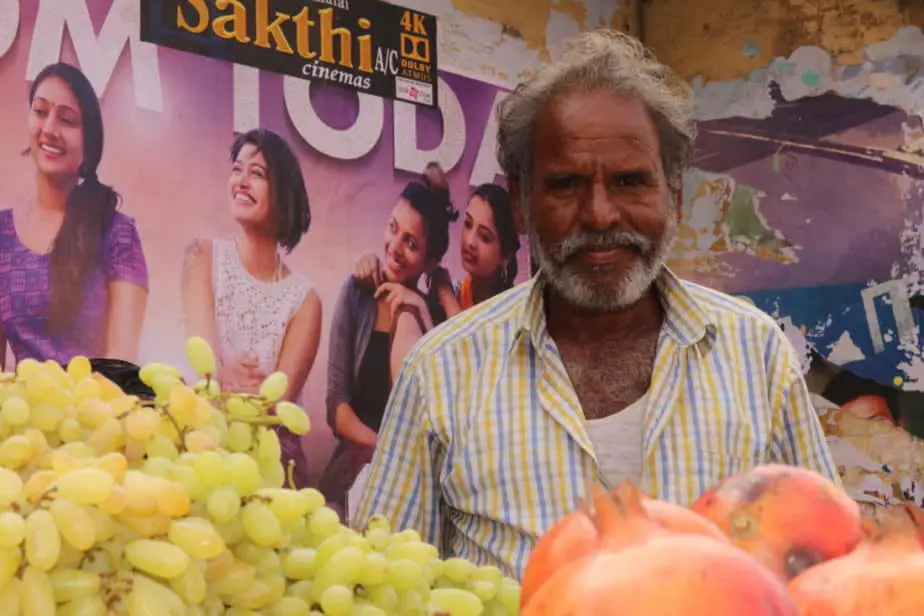
There are fruit stands everywhere in India and this is a great way to eat healthy, deliciously and usually inexpensively.
The mangoes in summer (March to July) are the creme de la creme of the fruit stands. There are over 1,000 types of mangoes in India, yet you might only see 4 types at a typical stall. I love the smaller ones because they are sweeter. But the larger ones are still good and you don’t have to do as much work to peel them.
Bananas are always in season and there are a number of options as well, from small to large. The larger ones are more for cooking and the littles ones are sweeter and ready to eat.
8) Supplement Your Vegan Diet

Eating green leafy salads is NOT advisable in India. You only want to eat foods that have been peeled, boiled, or cooked.
Since eating vegan will reduce your nutritional options it is advisable to supplement your diet with vitamins and minerals.
Doctors recommend Vitamin B12. Some other studies found various nutrients were lower in vegans therefore please ask your doctor for recommendations before coming to India.
9) Find Vegan Meetup Groups

Finding vegans as you travel could be easier than you think. One trait many vegans have is a passion for healthy eating and sharing it with others.
On Meetup.com, there are 13 groups vegan-related groups across India in cities like:
- Bangalore
- Kolkata
- Pune
- Hyderabad
- Mumbai
Or check Facebook for vegan groups, I see groups in cities like:
- Bangalore
- Chennai
- Coimbatore
- New Delhi
- Hyderabad
- Kolkata
- Pune
- Mumbai
10) It’s Okay To Cheat
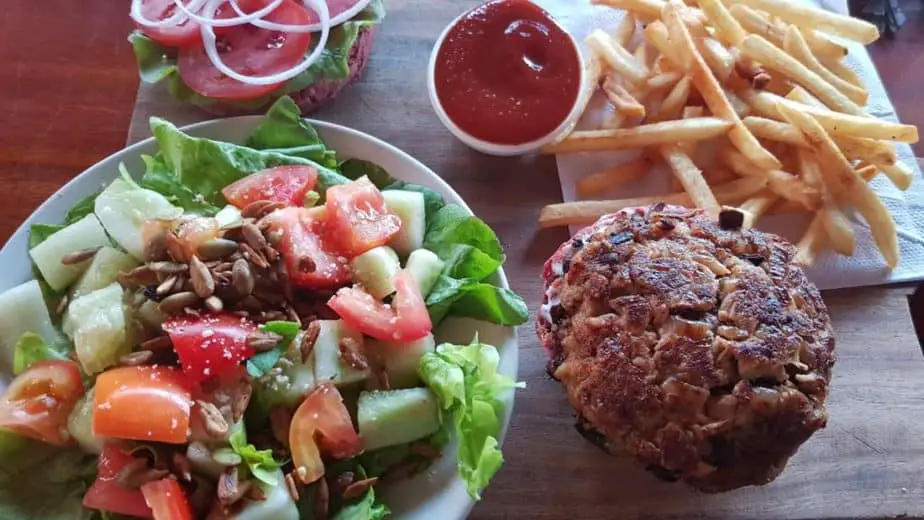
The happiest vegans I’ve met in India have all admitted to a bit of cheating, when necessary.
You may need to be a little open-minded about your diet in some places in India or in some situations.
Travel in India can be challenging even without strict dietary requirements, so if you have to eat something made with ghee or milk, don’t beat yourself up too much.
Many people have raved about their travels in India and how it has changed them, so if you were to hold a similar attitude, you could get the most from your trip and go home with a new perspective… where you can again enjoy delicious vegan food 🙂
Summary:
Eating vegan in India might not be easy, but with websites such as the Happy Cow and Vegan First, it can be done. If you plan your destinations with vegan restaurants in mind, as well as knowing the 36 common vegan-friendly dishes, then you can have an amazing trip in India… while also eating according to your values.
If you’re planning a trip to India, one weird question I found people asking was… Do Indian restaurants sprinkle cow urine on their food? I cover the answer in detail in that linked article after questioning a number of restaurant owners.
Related Articles:


